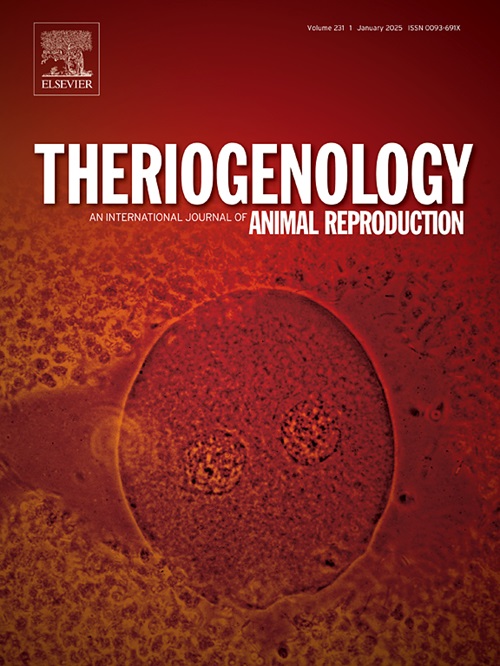Effect of glutathione addition on vitrification of ovine oocytes
IF 2.4
2区 农林科学
Q3 REPRODUCTIVE BIOLOGY
引用次数: 0
Abstract
The exogenous antioxidants are commonly employed to mitigate vitrification-induced oxidative damage. Glutathione (GSH), a vital antioxidant, plays a significant role in scavenging free radicals, providing antioxidant protection, and maintaining cellular integrity. This study aimed to investigate the effects of GSH supplementation on the vitrification of ovine oocytes. To identify the optimal concentration of exogenous GSH supplementation, the impacts of 2 mM, 4 mM, and 8 mM GSH on the survival and fragmentation of oocytes were evaluated after vitrification. In addition, immunofluorescence (IF) staining was employed to evaluate spindle morphology, chromosome distribution, cortical granule distribution, mitochondrial function, and reactive oxygen species (ROS) levels. The levels of ATP and NADPH, along with the ratio of GSH/GSSH, were also examined. Additionally, evaluations of in vitro fertilization were carried out. The results of oocyte survival rates and fragmentation rates identified that the addition of 4 mM GSH to the vitrification solution was the optimal concentration. The assessment of spindle morphology, chromosome distribution, cortical granule distribution, mitochondrial function, ROS production, ATP activity, and NADPH levels, as well as the GSH/GSSH ratio, confirm the beneficial effect of GSH supplementation against the vitrification-induced oxidative damage. Lastly, incorporating GSH into the vitrification process enhanced the developmental potential of oocytes, resulting in higher cleavage rates, increased blastocyst rates, and improved quality of blastocysts. Overall, this research uncovered the mechanisms through which GSH mitigates the oxidative damage induced by vitrification, thereby leading to the optimization of the vitrification technique for ovine oocytes.
添加谷胱甘肽对绵羊卵母细胞玻璃化的影响
外源性抗氧化剂通常用于减轻玻璃化引起的氧化损伤。谷胱甘肽(GSH)是一种重要的抗氧化剂,在清除自由基、提供抗氧化保护和维持细胞完整性方面起着重要作用。本研究旨在探讨谷胱甘肽对绵羊卵母细胞玻璃化的影响。为了确定外源谷胱甘肽补充的最佳浓度,我们评估了玻璃化后2 mM、4 mM和8 mM谷胱甘肽对卵母细胞存活和破碎的影响。此外,采用免疫荧光(IF)染色评估纺锤体形态、染色体分布、皮质颗粒分布、线粒体功能和活性氧(ROS)水平。ATP和NADPH的水平以及GSH/GSSH的比值也被检测。此外,还进行了体外受精评价。卵母细胞存活率和破碎率结果表明,玻璃化液中加入4 mM谷胱甘肽为最佳浓度。通过对纺锤体形态、染色体分布、皮质颗粒分布、线粒体功能、ROS产生、ATP活性、NADPH水平以及GSH/GSSH比值的评估,证实了补充GSH对玻璃化诱导的氧化损伤的有益作用。最后,在玻璃化过程中加入谷胱甘肽增强了卵母细胞的发育潜力,从而提高了卵裂率,增加了囊胚率,改善了囊胚质量。总的来说,本研究揭示了谷胱甘肽减轻玻璃化诱导的氧化损伤的机制,从而优化了羊卵母细胞的玻璃化技术。
本文章由计算机程序翻译,如有差异,请以英文原文为准。
求助全文
约1分钟内获得全文
求助全文
来源期刊

Theriogenology
农林科学-生殖生物学
CiteScore
5.50
自引率
14.30%
发文量
387
审稿时长
72 days
期刊介绍:
Theriogenology provides an international forum for researchers, clinicians, and industry professionals in animal reproductive biology. This acclaimed journal publishes articles on a wide range of topics in reproductive and developmental biology, of domestic mammal, avian, and aquatic species as well as wild species which are the object of veterinary care in research or conservation programs.
 求助内容:
求助内容: 应助结果提醒方式:
应助结果提醒方式:


